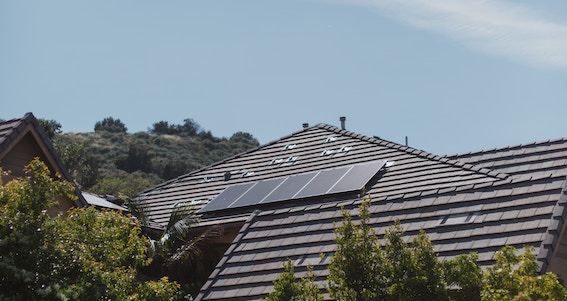Market research indicates the average Australian home has 17 connected devices; ‘smart’ devices in the internet of things that offer everything from efficiency to safety, convenience and entertainment.1 Renewable energy devices – behind the meter, on the roof and in your pocket – are the next frontier, offering real savings and the potential to power them all.
In 1981, you could buy a personal computer (PC) for about the same price as a used car. The next screen revolution – flat screen televisions – hit the market in the late 1990s to the tune of about $15,000 for a large model.
Prices dropped rapidly over the next decade as technology improved. Research shows the average Australian home now has 6.6 screens, including internet-capable televisions, tablets, smartphones and high definition televisions.2
So it goes that breakthrough technologies seem to be underestimated and overpriced at the outset, but costs decline rapidly as the technology improves and adoption becomes widespread.

The declining cost of renewable energy
Similar dynamics can be observed in renewable energy technology.
The climate crisis upon us and finite reserves of coal and gas capture a decade-long debate about how our electricity should be produced. In mainstream debates, renewable energy is increasingly being understood as a necessity, not a choice, to future-proof energy sources for homes and businesses.
For example, in 2017, onshore wind was named the world’s cheapest way to produce electricity. Its unsubsidised levelised cost of energy (LCOE) range of US$30-60 per megawatt hour (MWh) fell below the range of the cheapest fossil fuel, natural gas (US$42-78 per MWh). Solar was right behind as the world’s second-cheapest energy source, with the high end of its LCOE range (US$43–53/MWh) less than any other generation source. Globally, Australia has the lowest costs for solar-powered generation.3
If history repeats itself, this means that as energy companies transition their portfolios to hold greater proportions of renewable electricity generation, retail energy costs should decrease over time.
In the meantime, there are savings and gains to be made by investing in distributed energy resources (DER) that generate power directly for the home and reduce the amount of energy one needs to consume. Rooftop solar is the most common, with an investment case that’s more compelling than you might think.
Myth 1: Installing renewable energy in a home is a major expense
Rooftop solar, with or without a battery for storing your power, is one of the most commonly deployed DER solutions.
Australia’s Clean Energy Council estimates 1 in 5 rooftops have solar panels installed – including 2 million homes – with 6 panels installed each minute in 2018.
Recent market surveys indicate the average price across Australian capital cities for a 5kW system without battery storage is $5,100. A system of this size is generally suitable for a family of four and takes anywhere from two to seven years to pay for itself.4
As for batteries, market research suggests they are still relatively expensive, and the payback time will often be longer than the warranty period of the battery. The current cost is between $8,000 and $15,000 (installed), depending on capacity and brand.5 It’s worth checking what’s available in your area, as there are some government schemes that offer financial incentives. At a minimum, it’s worth making sure your system is ‘battery ready’ as battery costs are declining rapidly.
Myth 2: Long-term cost-savings aren’t that significant
According to Clean Energy Council Chief Executive Kane Thornton, homes with rooftop solar are saving on average about $540 per year on their electricity bills.
This represents a 25 percent saving on the average annual electricity bill of $2,088 for a four-person home.6
According to Choice, the price of a 5kW solar system has fallen by around 58 percent in the last six years – and the technology is getting cheaper.
Looking ahead
Distributed energy resources are set to play an increasing part in Australia’s energy system. These small-scale energy solutions are forecast to dramatically increase and deliver almost half of all electricity supplied by 2050.7
Current examples of DER include rooftop solar, batteries, microturbines, fuel cells, electric vehicles and ‘demand response’ applications that moderate consumption.
Solar is the most prevalent today and, while the technology is continually improving, it is already a compelling investment that is within the reach of many.
As technologies continue to improve, the choice and benefits for investor-owners in solar and other solutions should expand.
Source : AMP CAPITAL September 2019
1 Australian IoT@Home Market Study, Telsyte, 2019
2 Australian Video Viewing Report, Nielsen, 2018
3 Global renewable energy trends, Deloitte Insights, 2018
4 How to buy the best solar panels for your home, Choice, 2019
5 How to buy the best solar battery storage, Choice, 2019
6 What is the average electricity bill?, Canstar Blue, 2019
7 The Distributed Energy Integration Program, Australian Renewable Energy Agency, 2019
Important notes: While every care has been taken in the preparation of this article, AMP Capital Investors Limited (ABN 59 001 777 591, AFSL 232497) and AMP Capital Funds Management Limited (ABN 15 159 557 721, AFSL 426455) (AMP Capital) makes no representations or warranties as to the accuracy or completeness of any statement in it including, without limitation, any forecasts. Past performance is not a reliable indicator of future performance. This article has been prepared for the purpose of providing general information, without taking account of any particular investor’s objectives, financial situation or needs. An investor should, before making any investment decisions, consider the appropriateness of the information in this article, and seek professional advice, having regard to the investor’s objectives, financial situation and needs. This article is solely for the use of the party to whom it is provided and must not be provided to any other person or entity without the express written consent of AMP Capital.

